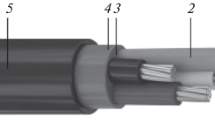Abstract
The resistance of heavy-gage current-carrying conductors to alternating current of industrial frequency increases due to the skin effect and proximity effect, which leads to increasing heat loss during transmission of electrical energy. When power cables for a voltage of 110 kV or more are fabricated, segmented Milliken-type current-carrying conductors are used, which make it possible to reduce the resistance to alternating current. The objective of this work is to carry out a numerical study of electromagnetic processes in heavy-gage Milliken-type current-carrying conductors using mathematical simulation. For this purpose, a geometric model is constructed that takes into account the complex spatial structure of current-carrying conductors. For comparison, a geometric model is considered in which the wires are arranged parallel to each other. The electromagnetic processes in the current-carrying conductors are described by differential equations for the complex amplitude of vector magnetic potential derived from Maxwell’s equations. The proposed set of differential equations is supplemented with corresponding boundary conditions. The given problem was solved numerically on the basis of the ANSYS Maxwell software package constructed based on the finite element method. As a result of calculations, the fields of vector magnetic potential in the whole volume under study and the distributions of the current density vector in conductors were obtained, from which the resistances of current-carrying conductors as a whole and of each wire separately were calculated. The calculation results revealed that using Milliken-type current-carrying conductors makes it possible to reduce the conductor resistance by equalizing the current density distribution over the cross sections of wires when a segment of them is twisted.





Similar content being viewed by others
REFERENCES
Belousov, A.E., et al., Elektricheskie kabeli, provoda i shnury. Spravochnik (Electrical Cables, Wires, and Cords: A Handbook), Moscow: Energoatomizdat, 1987.
Andreev, V.A., Portnov, E.L., and Kochanovskii, L.N., Napravlyayushchie sistemy elektrosvyazi. Tom 1. Teoriya peredachi i vliyaniya (Guiding Telecommunication Systems, Vol. 1: Theory of Transmission and Influence), Moscow: Goryachaya Liniya–Telekom, 2009.
Grigor’ev, A.D., Metody vychislitel’noi elektrodinamiki (Methods of Computational Electrodynamics), Moscow: Fizmatlit, 2012.
Soloveichik, Yu.G., Royak, M.E., and Persova, M.G., Metod konechnykh elementov dlya resheniya skalyarnykh i vektornykh zadach (Finite Element Method for Solution of Scalar and Vector Problems), Novosibirsk: Novosib. Gos. Tekh. Univ., 2007.
Bathe, K.-J., Finite Element Procedures, Upper Saddle River, NJ: Prentice Hall, 1996.
Grodnev, I.I. and Vernik, S.M., Linii svyazi (Telecommunication Lines), Moscow: Radio i Svyaz’, 1988.
Author information
Authors and Affiliations
Corresponding author
Additional information
Translated by M. Kromin
About this article
Cite this article
Koryukin, D.Y., Shcherbinin, A.G. Numerical Studies of Electromagnetic Processes in Segmented Heavy-Gage Current-Carrying Conductors. Russ. Electr. Engin. 90, 747–751 (2019). https://doi.org/10.3103/S1068371219110075
Received:
Revised:
Accepted:
Published:
Issue Date:
DOI: https://doi.org/10.3103/S1068371219110075




